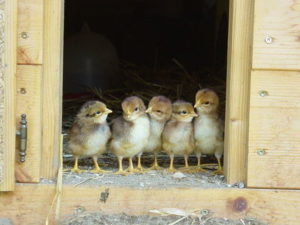 Between 6 and 8 weeks of age, your chicks will be much larger and will need twice the amount of floor space they started with.
Between 6 and 8 weeks of age, your chicks will be much larger and will need twice the amount of floor space they started with.
It’s also time to start thinking about moving your chicks from the brooder to more permanent living quarters outside. If the temperature is mild and the chicks are fully feathered, they can be allowed outside during the day. If you purchased straight-run chicks (50/50 males and females) you may be able to distinguish the males from the females around 5 to 7 weeks of age. The combs and wattles of the males usually develop earlier and are usually (but not always) larger than in the females. Females are typically smaller in size than males. If you are still uncertain of their sex by appearance, you’ll be sure who the males in the flock are when you hear them attempting to crow.
Your chicks are able to regulate their body temperature by this time and should not need a heat source any longer unless the outside temperatures are still very cold. Keep temperature at 65°F if this is the case.
Prepare your chicken house or coop. Housing should provide approximately three to four square feet of space per mature bird and should contain sufficient feeders and waterers to accommodate your flock size so that all birds can eat and drink at the same time. Two to three inches of litter should be put down to minimize dampness and odor. A nest box for every four hens should be made available for laying pullets. Roosts can be considered for laying pullets but not recommended for meat birds because of the potential for developing breast blisters.
If possible, prepare an area outside the coop for your birds. Outside runs or fenced in areas will allow chickens to scratch and peck to their hearts desire, returning to the roost at dusk to sleep. The house needs to have a secure latch that is fastened each night if they are allowed outside during the day. An outside run attached to the coop with screening on the top and sides for protection will allow chickens unlimited access to the yard and save you time and worry.
Once you move your birds to their permanent residence, make sure they are protected from predators, especially at night. Even a latched door may not be secure enough to keep raccoons out.
- Your birds are still growing so keep feeding Purina® Start & Grow® Recipe to help them reach their maximum potential. Chicks should remain on this feed until at least 18 weeks of age.
- If your flock is a mix of chicks, ducks and geese, continue feeding Purina® Flock Raiser Recipe.
- Turkeys can start on Purina® Flock Raiser® at 8-10 weeks of age. Keep feeding this until market weight or laying age.
- If chicks were purchased for meat production, the normal weight for processing is 3 to 4 pounds for broilers and 6 to 8 pounds for roasters.
Laying pullets will need to receive a constant amount of light exposure once they reach 16 weeks of age to promote good egg production. For optimum egg production, a maximum of 17-18 hours of light (natural and/or artificial) per day is recommended. Gradually transition to Purina® Layena® Premium Poultry Feed or Purina®Organic Layer Feed at 18-20 weeks to support egg production.
Pullets will usually begin laying between 18 and 22 weeks of age. Increasing day length in the spring stimulates normal egg production, and egg production is naturally decreased in the fall when the days get shorter. Artificial light can be used in addition to natural daylight in the fall and winter months to maintain egg production all year long. If artificial light is not used, hens will stop laying when daylight hours decrease. It is very important that the supplemental light be consistent, as even one day without supplemental lighting can cause a decrease in egg production.
After 10-14 months of egg production, hens will molt and stop laying eggs. During molting, old feathers are lost and replaced by new feathers. It usually lasts between eight and twelve weeks (though it can be shorter or longer, depending on the individual hen and her environment) and it gives the hen’s reproductive system some much needed rest. Hens will return to production after the molt. Eggs laid in the next cycle are usually larger with improved shell quality but production typically drops about 10 percent.
Article Attributed to Purina Animal Nutrition




